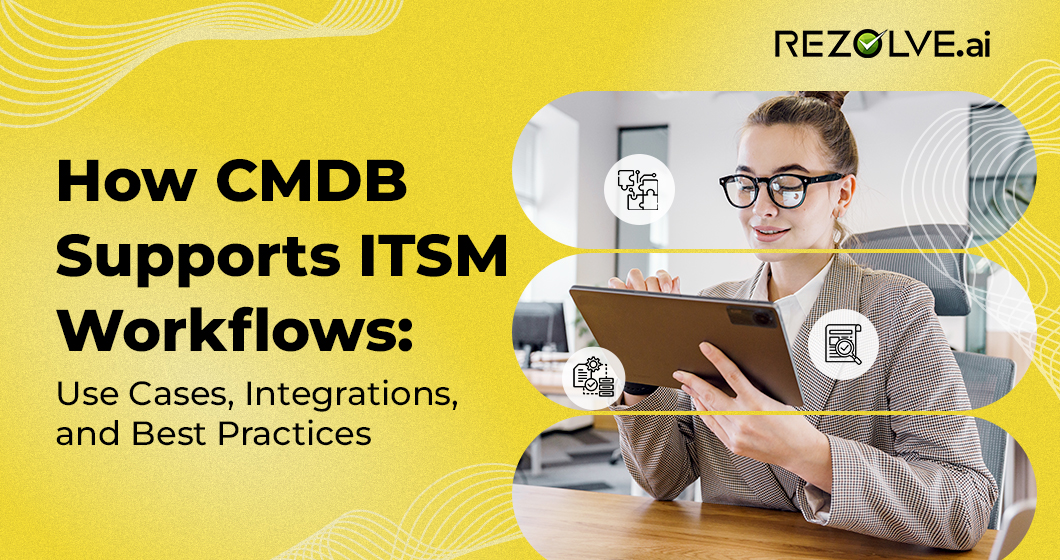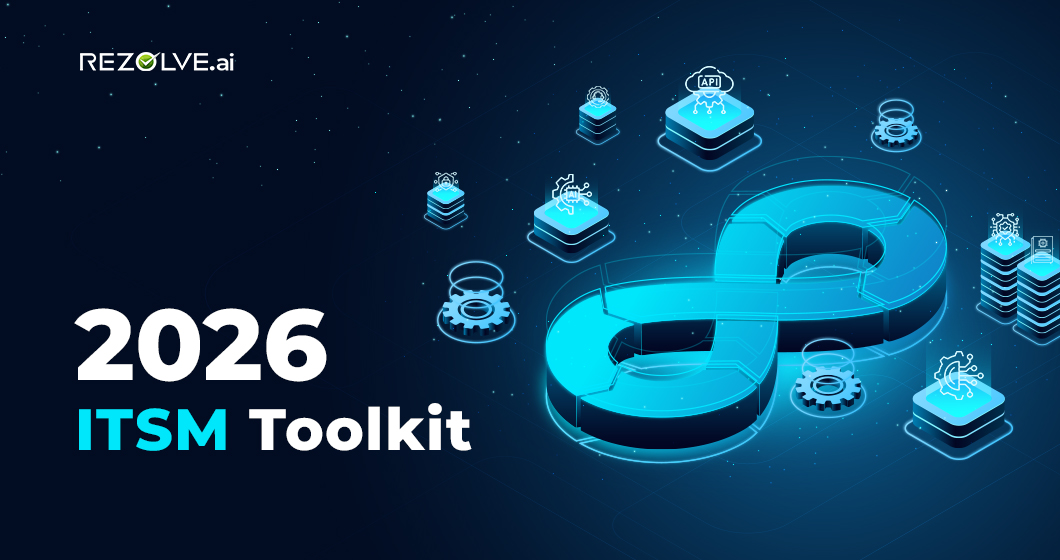A Configuration Management Database or CMDB is a fundamental part of IT Service Management. But usually, it is either underutilized or misunderstood. Many organizations deploy one but don’t see consistent value - not because the concept is flawed, but because implementation gets disconnected from real workflows and employee support needs.
A well-structured CMDB is a place to store IT assets, ticketing, and data records. It’s a system of records that supports critical ITSM functions like incident management, change control, service requests, and problem resolution. When kept up to date and aligned with service workflows, it reduces resolution times, improves automation, and strengthens governance.
But getting the CMDB right requires moving past the idea of “just tracking assets” and towards an integrated, usable, and constantly evolving model of your IT environment.
Let’s see how CMDB supports ITSM workflows for enterprises.
Role of CMDB in ITSM
In practical terms, a CMDB gives your ITSM platform eyes and ears. Without it, service desks handle tickets in isolation. Change managers make decisions without a full risk picture. Automation scripts operate on assumptions. With the CMDB in place, every CI-server, switch, cloud resource, and software system has context. The context involves what a particular asset/system does, who owns it, what it’s linked to, and what happens if it fails.
A CMDB is about making available ITSM data useful. And that usefulness shows up across ITSM processes, not in the database itself.
Where CMDB Directly Improves ITSM Workflows?
.png)
Let’s look at where CMDB moves the needle when it comes to everyday IT workflows.
CMDB for Faster Incident Management Triage
Most service desks operate under time pressure. When a critical application goes down, support teams don’t have enough time to dig through spreadsheets.
With a populated CMDB, incidents are linked to their affected configuration items. This allows agents to quickly understand which service is impacted, what infrastructure it depends on, and whether other components are affected. Agents can quickly make sense of potential causes, known relationships, and past incident history, i.e. connect the dots related to the IT incident.
This contextual triage makes life easier for L1 support and helps reduce escalations, shorten resolution times, and avoid duplication of effort. And because everything is logged at the CI (Configuration Item) level, trends become easier to spot, enabling long-term improvements in problem management as well.
Impact Analysis for Change Management
Approving a change request without knowing what depends on the system being modified can result in potential outages. CMDB makes impact analysis of the proposed change as a structured process rather than a guessing game.
For instance, a team wants to apply an update to a backend database. With a functioning CMDB, change managers can pull up all the services connected to that database, see who owns each one, and notify affected stakeholders beforehand. Combined with CI history and incident patterns, this data helps assess the risk of failure and outage. Agents can also assign the right change category and identify fallback paths if something goes wrong.
Impact analysis also helps with post-change reviews. If something breaks after a release, the CMDB logs which items were altered and which services they supported. That means faster rollback, clearer accountability, and less operational disruption in the day-to-day IT workflows.
Mapping Root Causes for Problem Management
Recurring issues are a major drain on service desks. Solving them requires seeing the bigger picture. CMDB supports this by helping problem managers connect incident trends to shared CIs. If three different business services are reporting performance issues, and all rely on the same application server cluster, the CMDB helps trace those dependencies. Instead of investigating each issue in isolation, the problem management team can focus on the shared infrastructure.
Over time, this approach builds a stronger preventive culture. Known error databases become more reliable, and proactive monitoring becomes more effective. With a CMDB in place, IT teams can avoid fixing just surface symptoms and address the root cause in a timely manner.
Smarter Service Request Management with CMDB
Many service requests include repetitive requests like access to a tool, a new device, or a license upgrade. But fulfilling them well depends on understanding the environment they’re tied to. CMDB provides this understanding.
Here is an example for more clarity. Take a request for remote access. If the CMDB shows the requester’s role, existing entitlements, and linked services, the request can be processed faster, with fewer checks and less back-and-forth. Similarly, requests for new hardware can be matched to available inventory or policy requirements using real-time CI data.
The difference here is automation and precision. When the request process is aware of the system state, approvals are smarter and quicker. Moreover, the probability of errors goes down significantly.
Asset and Lifecycle Management with CMDB
While CMDBs are often mistaken for asset inventories, their actual strength is in managing the full lifecycle of configuration items across physical, virtual, and cloud-based environments.
You’re not just tracking “a laptop” or “a VM.” You track its role, its relationships, its configuration changes, and its operational state. This helps plan for renewals, reduce shadow IT, and stay compliant with audits and licensing agreements.
It also gives finance and operations teams a real-time picture of asset utilization. This makes budget forecasts more grounded in actual usage and service value instead of just static procurement records.
CMDB Integrations in ITSM Ecosystem
.png)
A CMDB doesn’t become useful through data population alone. It becomes useful when it integrates seamlessly into your existing ITSM ecosystem. Without that integration, it becomes stale and forgotten, another underused tool with a long implementation story. Actually, this is where Agentic AI-powered ITSM and CMDB shines. But more on that later.
More Context for Discovery Tools
Automated discovery is essential for scale. Tools like SCCM, AWS Config, and Azure Resource Graph help identify systems and keep their properties up to date. But these tools don’t know what services those systems support or what the business impact is if they go offline. That’s where the human layer and CMDB enrichment matter. Combining discovery data with service mapping, CI ownership, and classification ensures that your CMDB isn't just technically accurate but also operationally relevant.
Ticketing Systems add Daily Touchpoints for CI Usage
Integrating the CMDB with service desk software turns CIs into part of the workflow. With it, agents can select affected items during ticket creation, change planners pull dependencies before approvals, and problem managers use CI history for root cause analysis.
This regular use helps build habits. More importantly, it keeps the CMDB alive. When teams use it to get work done, they’re more likely to keep it current.
Monitoring and Observability Become Actionable with CI Relationships
Monitoring systems often flood dashboards with alerts. Without a CMDB, these alerts remain isolated events. With one, they gain context. For instance, if a disk space alert is tied to a CI that supports a customer portal, it’s now a potential revenue risk. If it’s tied to a backup system during non-critical hours, it might be deprioritized. A CMDB helps prioritize response by aligning monitoring data with actual service impact.
What Makes a CMDB Work Effectively?
.png)
A successful CMDB isn’t necessarily large but highly relevant. Here’s what tends to separate the ones that succeed from the ones that become shelfware.
Enterprises must start small and solve one clear problem first. Think incident routing, change impact analysis, or asset visibility i.e. all strong use cases to begin with. Then, enterprises must build only the CI records and relationships needed for that goal. Once it delivers value, companies can expand gradually, layer by layer.
Also, if you are deploying a CMDB for the first time, avoid over-modeling. You don’t need to capture every port on every switch. Stick to the relationships that help someone make a decision. Focus on what supports services, what could impact availability, and what people need to fix issues faster. Define ownership clearly. Every CI should have an accountable person or team. This avoids scenarios when data gets stale or changes remain untracked.
And finally, embed CMDB usage in daily work. Don’t treat it as an admin exercise. Make CI selection part of ticket forms. Review CI data as part of sprint planning. Use it in incident retrospectives. If it becomes part of the routine, it remains relevant.
Implement CMDB for the Long Run
It’s tempting to treat the CMDB like a product you implement once and forget. But the reality is that a good CMDB is more like a garden. It needs planning, maintenance, pruning, and review. Left alone, it gets messy. Actively managed, it becomes a foundational layer for service quality and operational maturity.
If you’re already working with a CMDB, ask yourself: is it helping people do their jobs better today? If not, revisit the workflows and fix the integration points. That’s the real test of a CMDB’s value - how often it is used when it really matters.

.png)



.webp)




.jpg)

.png)








.png)